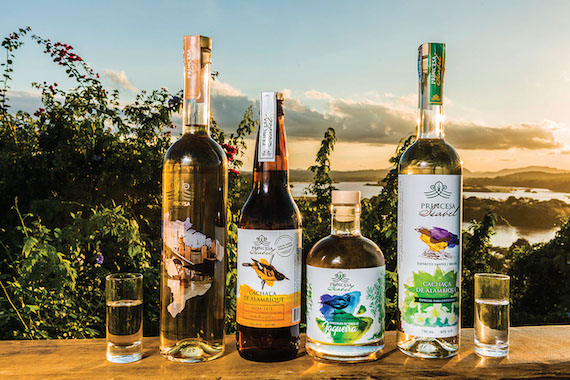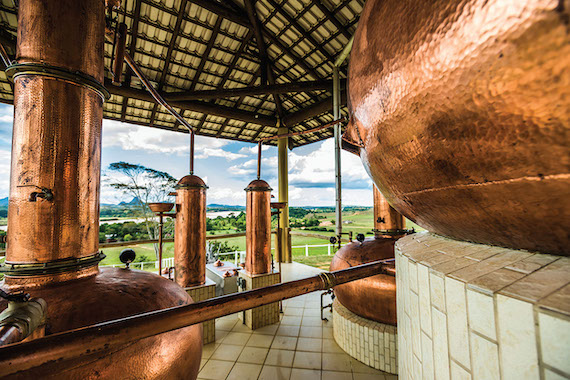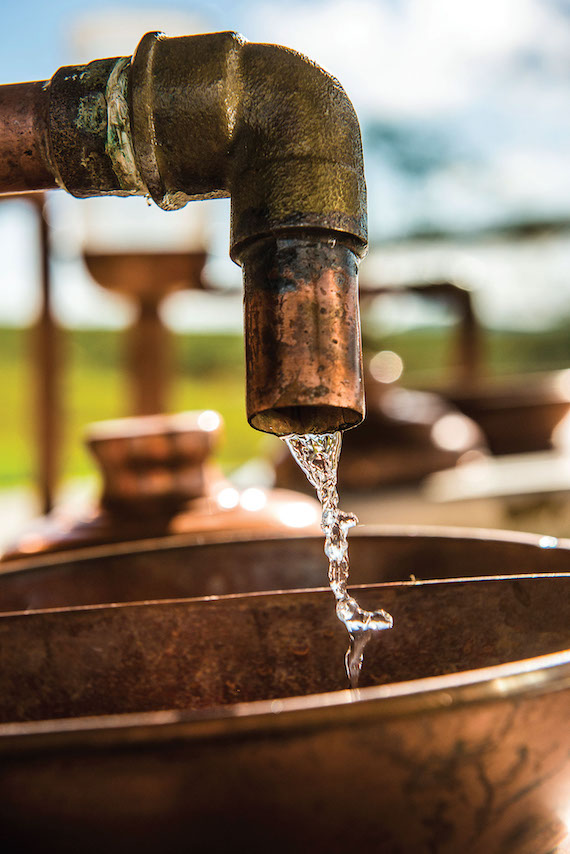If life gives you limes, make Caipirinhas. The sweet yet zingy cocktail muddled with the green citrus fruit, white cachaça and sugar fuels Brazilians and, given that they consume 99% of the 800 million litres of the spirit produced in their country each year, it seems they rather like it.
But there’s more to this raw sugarcane juice distillate whose ambassadorial vehicle is the delicious Caipirinha. Microdistilleries located all over the world’s fifth-largest country age their base white or pure cachaça (also known as pinga and abre-coração, or heartopener) in casks made of local wood, also blending barrels to create new levels of expression – and their efforts are enhancing the flavour wheel of what the IWSR calls the world’s third-most consumed spirit. It’s an exciting time to be a connoisseur, says Peter Banks, founder of Cachacier, a cachaça experience, and a US transplant living in capital city Brasilia.
“Over the past 15 to 20 years, several elements have come together to move cachaça forward: producers interested in making high-quality spirits; access to technological knowledge to create them; and a public interested in a uniquely Brazilian spirit,” he says.
The sugarcane distillate hasn’t always curried favour at home. Its story begins in the 16th century when the Portuguese disembarked in South America with the Asian perennial grass they had already successfully test-driven in Madeira. Brazil’s widespread fertile lands – from the redsoiled south to the tropical north east – ensured the crop adapted easily, and so an agricultural industry was born. When the first sugar mill was constructed in São Paulo state in the mid-1600s, the Portuguese knowhow for distilling meant alcohol production fast followed suit, according to Bíblia da Cachaça. The history of cagassa, its original name, is chequered: alongside tobacco and sugar commodities, it was a bartering currency used for purchasing African slaves, while heavy taxation of the distillate from Portugal resulted in an uprising in 1660, today known as the Cachaça Revolt.
Pure, or white, cachaça is the most popular style, and production is dominated by Brazil’s three industrial giants – Pirassununga 51, Velho Barreiro and Diageo-owned Ypióca – the style considered by Brazil’s wealthy class to be a poor man’s liquor that’s lacking complexity. Thousands of microdistilleries, however, are changing the narrative, creating complex flavour profiles by ageing in native wood barrels for two or three years, their humble 20,000 litres each contributing to those 800 million litres registered by Brazil’s Ibrac institute. But, given that 89% of 40,000 or so distilleries aren’t offi - cially registered, how do they start reaching consumers? By linking them to gastronomy, says chef-patron Rodrigo Oliveira of Mocotó in São Paulo, craft cachaça’s original champion in the culinary world.
He says: “It’s almost impossible to talk about Brazil’s culinary world without paying tribute to cachaça. When I started working at the restaurant in the early 1990s, there was a lot of prejudice around the beverage’s consumption because it was cheap [and consumed by the working class]. But I saw something beautiful and started meeting generations of families craft ing high-quality spirits, and understood there was more to show than those cheap brands.”
By stocking craft products at Mocotó, Oliveira pioneered a trend that’s followed today by establishments across Brazil. In gastronomy capital São Paulo, top bars that appreciate cachaça include Tan Tan, Subastor and Santana, while restaurants include Evvai, A Casa do Porco, Maní and DOM.
When the Corrêa Bastos siblings, chef Marcelo and drinks director Nina, opened Jiquitaia 10 years ago, just 5% of the alcohol they sold was cachaça. That fi gure is now 95%, she says, aft er a decade of educating their diners. “Artisanal cachaça is changing our market and increasing consumption across all social classes,” she says.

IDENTIFYING WITH DIVERSITY
Its heritage has contributed to a new wave of enthusiasts, says Banks. “Imagine, cachaça has existed since before Brazil officially became a country, so Brazilians consider it to be an important part of their history. Given that it has European, African and Asian influences, when Brazilians think about diversity, it’s almost the perfect representation of their culture. They identify with it and that’s meaningful: politics is divisive right now and people find common ground in cachaça.”
But there are still hurdles to overcome, and today’s craft set-ups label their wares as cachaça de alambique (from stills), given that the word ‘artesanal’ in Portuguese is commonly construed as ‘poorly made’. In addition, many only sell locally due to the high taxes imposed when ‘exporting’ across interstate borders, never mind the red tape required to become a legal business. One microdistillery, however, is achieving success outside of its home state of Espírito Santo, and is to start exporting to the US with Banks.
A family-run project, Adão Cellia and his son Pedro Cellia, both cardiologists, began cultivating sugarcane in 2012 on farmland in Linhares, located next to the River Doce close to the Serra do Mar mountain range; they also raise cattle and cultivate cacao. But it’s their 8ha planted with four varieties of organic sugarcane that most excites Adão, a cachaça aficionado for 50 years. Together, in 2016, they released their first branded spirit as Destilería Princesa Isabel, named after Pedro’s mother.
“It was my dad’s dream to cultivate something exquisite on the land he loves at Fazenda Tupã farm, and make an incredible product – that’s a tribute,” says Pedro Cellia.
Today producing an eight-strong line split across 25,000 litres a year, Princesa Isabel’s white Prata label is the base for the seven barrel-aged products, boosting cachaça’s Brazilian identity by choosing local woods over used bourbon casks. It uses several varieties, including jaqueira (jackfruit; known for yellow fruit flavours), jequitibá (Brazilian mahogany), balsámo (balsam; herbal, aniseed and yellow fruit notes), castanheira (chestnut) and amburana (floral); the former is particularly appreciated, he adds.
“Lots of spirits are aged in oak; we wanted to age ours in Brazilian woods,” he says.
“In 2015, some jackfruit trees on our farm fell during a storm, but my dad rescued the wood and got our cooper to make a 5,000-litre cask.” An elegant spirit, it has picked up a cluster of awards, including an IWSC silver award in 2017, for its fascinating ginger notes. Besides cultivating organic sugar cane, the family has also planted 1,000 amburana trees to date.
Autochthonous wood ageing is writing the next chapter in cachaça’s story, according to Alex Mesquita, creative director at Tan Tan bar in Sao Paulo, which ranks in the top 100 of the World’s 50 Best Bars.
“Those aged in Brazilian wood are the most notable, in my opinion,” he says. “Three in particular have become popular: amburana, bálsamo and jequitibá, although Brazil has dozens of others that offer up different aromatic ageing characteristics.”
The ever-growing number of aficionados appreciates this diversity, says sommelier Banks. “The burgeoning community, which has been emerging over the past 20 years and has exploded over the past five, appreciates cachaça like whisky lovers, because there’s so much diversity of flavour based on what barrel it’s been aged in, the region it was aged in and its alcohol content,” he adds.
“People are interested in sharing with other cachaceiros, who gather to celebrate and appreciate this spirit. There are local clubs that meet every month in most major cities, usually with a guest distiller sharing their product – it’s become a way of life for this community.”
While many enjoy sipping cachaça as if it were a brandy or whisky, it also makes for a dynamic replacement in classic cocktail making, says Mesquita, and there’s a holy Brazilian trinity of cachaça-based cocktails. A twist on the Manhattan, the Rabo de Galo prepared by Mesquita uses 60ml of cachaça superior, and the cocktail has become so appreciated that many regional festivals host competitions to find the best.
Meanwhile, the Macunaíma, a contemporary sour created by bartender Arnaldo Hirai of São Paulo’s Boca de Ouro, uses white cachaça, Fernet, simple syrup and lemon juice. Bombeirinho (Fireman) uses 50ml cachaça superior, 25ml tahití green lemon and 20ml grenadine, garnished with a lemon slice.
Consumers should also consider replacing gin with an aged amburana cachaça in Negronis, adds Cellia.

INNOVATIONS
Blending Brazilian woods has become normal practice, as distillers look to balance out flavours and aromas and obtain new expressions, says Cellia. “We mix balsam with jaqueira-aged cachaça for two years because the former can be very intense and the jackfruit helps balance it out.”
Chef Oliveira agrees this exploration is crucial: “There are dozens of types of wood that go beyond oak. Ageing white cachaça in these barrels results in different spirits and we’re now exploring other styles… we’re producing a special edition blended with four different woods for Mocotó, for example.”
Single-barrel releases are also hitting the right notes with consumers eager to try something special, while Cellia’s latest innovation is a riff on sherry’s solera system, currently in its third and final year and due for release by year end. “By blending cachaça in ipê (trumpet tree), castanheira and jequitibá-rosa casks, we are creating our very own Brazilian style [of fractional blending],” he says.

BRIGHT FUTURE
Given that just 1% of cachaça is exported, there are plenty of opportunities to break these craft gems into new markets. However, importers need to appreciate them, says Banks.
“Producers have to partner with the right people who aren’t just after a novelty and are interested in these serious spirits. That said, the future is bright and cachaça is ready for the international market: it’s exciting, it crosses age, gender and socioeconomic status. It is ready to take on the world,” adds Banks.
With Brazil’s national cachaça day coming up on September 17, the timing is just right to sample it – if you can get your hands on a bottle.




